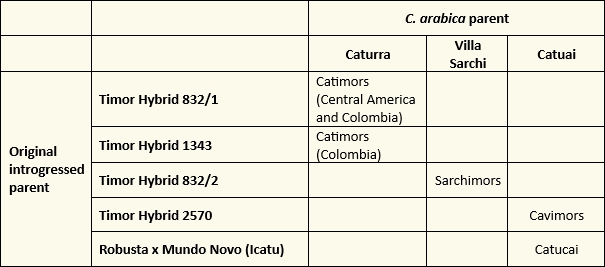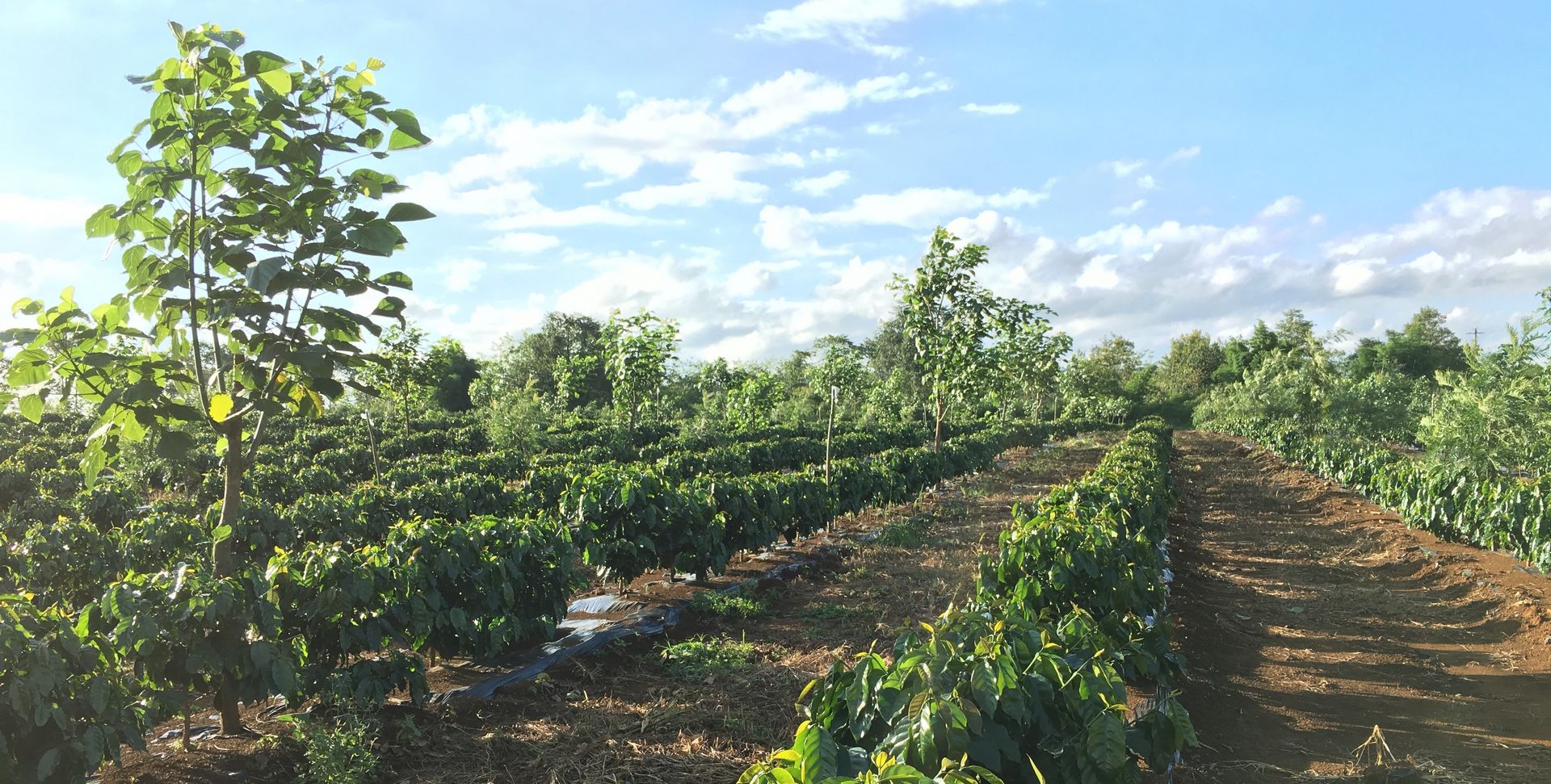Understanding the different categories of coffee cultivars
Cultivars are made of genetic unit(s). It is important to understand the different categories and talk the same language. These genetic units are the ones that are the source for further mass distribution to farmers. The multiplication itself can be :
- Sexual: taking advantage of the sexual reproduction of the plant through seeds. In the Coffea genus, there are two situations:
- Coffea canephora and almost all other Coffea diploid species (except C. heterocalyx and C. anthonyi) are strictly allogamous (=outcrossing). It means that a plant cannot fertilize itself. Furthermore, a plant cannot cross-pollinate with another plant if they have exactly the same genetic pattern (or genotype); this is the case for the plants of a same clone.
- C. arabica is autogamous (= self-pollinating), meaning that it can both self and cross-pollinate. According to available literature, the % of self-pollination for an arabica tree is 75% on average.
- Vegetative: taking advantage of the properties of the plant to be vegetally propagated. It can be through horticultural or tissue culture propagation. In this case, clones are mass produced.
Let’s see what are the different types a coffee cultivars :
- Fixed lines: A fixed line is made of one single genotype, virtually 100% homozygous, meaning that there is only one form of allele at each given locus. A fixed line shall be highly uniform in a field. Only variation will be due to the environment and not to genetics. As soon as no external pollen is participating to the pollination, the seeds harvested on a tree pertaining to a given fixed line will be genetically strictly similar to that given fixed line. This is why it is said to be ‘fixed’.
The most frequent and natural way to get a fixed line is to go through many generations of selfing. Indeed, selfing is increasing the % of homozygosity at each generation. Obviously, only C. arabica is eligible to fixed lines as it is autogamous. C. canephora is not.
For the record, there is another, yet artificial, way to get fixed lines through haplo-diploidization. The only C. canephora fixed lines obtained for research purposes are double haploids resulting from this technology. For instance, when you want to sequence the genome of a species, it is much easier when you possibly have a 100% homozygous individual. A double haploid plant of C. canephora was used for the first sequencing of this species.
- Clones: A clone is a group of plants which are genetically strictly similar. This group of plants is obtained from a mother tree which is “photocopied” through vegetative (horticultural or tissue culture) methods. Clones can be found in both C. arabica and C. canephora species.
- Crosses or Hybrids: The progeny of a cross can form the genetic unit of a cultivar. A cross is involving two parents –say A and B. When you cross A and B, you get seeds that have A and B as parents. If one or both parents are heterozygous, the progeny will be heterogeneous. The larger the heterozygosity of at least one of the parents, the higher the heterogeneity of the progeny.
- Specific case of F1 hybrids: Some crosses are remarkable; they are called F1 hybrids. A cross is called a F1 hybrid when i) both parents are highly homozygous, ultimately fixed lines and ii) parents are genetically distant. Such F1 hybrids display two interesting properties:
- They show what breeders call “Hybrid vigor” or “heterosis”, meaning that the F1 hybrid is performing better than any of the parents. This is related to the genetic distance between the parents.
- They are very uniform because both parents are highly homozygous.
Some Arabica F1 hybrids are well known for the last decades: CentroAmericano, Milenio, MundoMaya, Starmaya…
In C. canephora, strictly speaking, it is not possible to get a F1 hybrid because you can’t get parents that would be fixed lines. However, crosses between canephora parents that are genetically very distant are sometimes called F1 hybrids (Leroy et al, 1993; Montagnon et al, 2012), even if the name “Pseudo F1-hybrids” would be more appropriate.
– Complex (or multiple) hybrids: Sometimes the parents of a cross or a hybrid are themselves descending from other crosses for which the parents are well known and were chosen on purpose by the breeders. It is often used to combine genetic factors of resistance to one or more diseases from different parents. In coffee, Kenyan (Ruiru 11) and Tanzanian breeders have used such crossing in their breeding program to control both coffee leaf rust and coffee berry disease while maintaining cup quality.
– Composite cultivars: Composite cultivars are cultivars made of several genetic units. The genetic units might be fixed lines, clones or crosses. Few arabica cultivars are composite cultivars made of different fixed lines such as Colombia, Castillo and Batian. Ruiru11 is one of the few arabica composite cultivars made of (complex) crosses. On the other hand, a lot of Canephora cultivars are composite cultivars made of clones. For instance, most Canephora cultivars in Brazil are composite cultivars of clones: ‘Diamante ES8112’ or ‘Marilândia ES 8143’ for instance.
– Population cultivars: Population cultivars are made of seeds obtained from the inter-pollination of several parents. In this case, a given set of individuals are selected as parents and the seeds are resulting from random crosses between these parents. A population cultivar might be a cultivar that has not been totally fixed through selfing generation. In other words, breeding has stopped before reaching the “fixed line” status. In arabica, some populations cultivars are in the 5 or 6th generation of selfing. At this stage, the selfing is not controlled anymore and the population is just reproduced as it is. That would be the case of T.8667 or T.5175, but also the case of Pacamara or Anacafé 14 for instance. As compared to a fixed line, these population are more heterogeneous. In canephora, it is often the case that selected clones are used as parents for producing a Population Cultivar under the form of seeds. One good example is the cultivar ‘Emcaper 8151 – Robusta Tropical’ from Brazil.
All the previous cultivars have one feature in common: they can be stably reproduced from the fixed line itself, from the parents of crosses or from the mother tree of clones.
Landraces: A landrace is genetically heterogeneous and has evolved or is evolving in a certain ecogeographical area and is adapted to its environment and traditional management and use. Important characteristic of a landrace is its unstable state in constant even if slight evolution. For this reason, it is not easy to clearly describe it, as this description is volatile. If at some point, a given plot of a given landrace is chosen to be the only one for further seed multiplications, then it becomes a Population cultivar. On the other hand, if a specific breeding process withing the cultivar is started to get the very best individuals, then it could ultimately give rise to some fixed lines.
Another interesting note is that the uncontrolled pollination of different existing cultivars might have produced some specific landraces. I would argue that it is the case for Arabica in some parts of Central and East Africa, as well as in East Timor for instance.
Note on introgression
Breeders call it introgression when genes of a donor species have been introduced into a recipient species. This concept is very important in C. arabica where genes from C. canephora have been introduced through natural (Timor Hybrids) or controlled pollination to produce Catimors, Sarchimors…Such cultivars are called “introgressed cultivars”. Any category of cultivar might be introgressed or not depending on previous introgression in making up the cultivar.
However, introgressed Arabicas have also been produced from C. racemosa or C. liberica for instance. C. canephora has not been introgressed but in some cases with C. congensis (Congustas).
By far, the introgressed arabica cultivars have received genes from C. canephora. The following table describes the main “families” of C. canephora introgressed cultivars depending on the initial cross they are deriving from:

Genetic homogeneity versus heterogeneity
Two levels of evaluation of genetic homo or heterogeneity can be defined :
- At the level of the individual plant: the genetic heterogeneity of an individual plant is measured by its level of heterozygosity. From this point of view, a fixed line is the most homogeneous, and then the least heterogeneous at the level of the plant while the F1 and complex hybrids are the most heterogeneous.
Furthermore, the genetic diversity of the ancestors of a given individual plant will also play a role in the genetic heterogeneity of a plant. For instance, a fixed line coming from a narrow genetic population or a single genetic group (say Bourbon or Typica) will have less inherent genetic diversity that a Batian, resulting from the selfing of crosses involving parents from different genetic groups. The same is true for introgressed fixed line cultivars.
- At the level of the cultivar: At the level of a cultivar, the genetic heterogeneity is measured by the allelic richness of this cultivar. Composite cultivars can be richer than fixed lines or single clones if the fixed lines / clones constituting the composite cultivars are genetically different. The same apply to a population cultivar depending on the genetic diversity of the various parents of the given population.
Genetic homogeneity of a cultivar is a desired feature when the farming system is highly controlled and standardized. However, genetic heterogeneity brings biodiversity at the level of the cultivated coffee itself and might be an important component of resilience.

